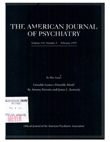The Wender Utah Rating Scale: an aid in the retrospective diagnosis of childhood attention deficit hyperactivity disorder [published erratum appears in Am J Psychiatry 1993 Aug;150(8):1280]
Abstract
OBJECTIVE: In an attempt to surmount the problem of retrospectively establishing the childhood diagnosis of attention deficit hyperactivity disorder, the authors constructed the 61-item Wender Utah Rating Scale (WURS) for adults to use to describe their own childhood behavior. In this paper they present their initial data collection and evaluation of the instrument's validity. METHOD: The scale was administered to 81 adult outpatients with attention deficit hyperactivity disorder, 100 "normal" adults, and 70 psychiatric adult outpatients with unipolar depression. The authors analyzed data from the 25 items of the scale that showed the greatest difference between the patients with attention deficit hyperactivity disorder and the normal comparison subjects and the relationship between the WURS and the patients' parents' judgment of childhood activity as measured by the Parents' Rating Scale. RESULTS: The patients with attention deficit hyperactivity disorder had significantly higher mean scores on all 25 items than did the two comparison groups. The difference between the mean total scores of the patients with attention deficit hyperactivity disorder and the normal subjects was also highly significant. A cutoff score of 46 or higher correctly identified 86% of the patients with attention deficit hyperactivity disorder, 99% of the normal subjects, and 81% of the depressed subjects. Correlations obtained between WURS scores and Parents' Rating Scale scores were moderate but impressive. The ability of WURS scores to predict response to methylphenidate replicated the authors' finding regarding the ability of Parents' Rating Scale scores to predict response to pemoline. CONCLUSIONS: The WURS is sensitive in identifying childhood attention deficit hyperactivity disorder and may be useful in recognizing attention deficit hyperactivity disorder in patients with ambiguous adult psychopathology.
Access content
To read the fulltext, please use one of the options below to sign in or purchase access.- Personal login
- Institutional Login
- Sign in via OpenAthens
- Register for access
-
Please login/register if you wish to pair your device and check access availability.
Not a subscriber?
PsychiatryOnline subscription options offer access to the DSM-5 library, books, journals, CME, and patient resources. This all-in-one virtual library provides psychiatrists and mental health professionals with key resources for diagnosis, treatment, research, and professional development.
Need more help? PsychiatryOnline Customer Service may be reached by emailing [email protected] or by calling 800-368-5777 (in the U.S.) or 703-907-7322 (outside the U.S.).



